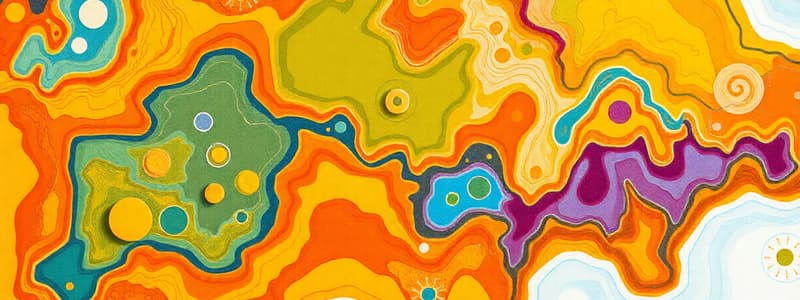Podcast
Questions and Answers
What does a ratio scale of 1:40,000 mean?
What does a ratio scale of 1:40,000 mean?
- 1 cm on the map represents 400,000 cm on the ground (correct)
- 1 meter on the map represents 40,000 meters on the ground
- 1 km on the map represents 40,000 km on the ground
- 1 inch on the map represents 40,000 inches on the ground
A word scale expresses a relationship using numbers.
A word scale expresses a relationship using numbers.
False (B)
Why are map scales important?
Why are map scales important?
Map scales are important because they indicate the relationship between distances on the map and actual distances on the ground.
A linear scale is shown as a _____ with marked intervals representing distance.
A linear scale is shown as a _____ with marked intervals representing distance.
Match the following types of scales with their definitions:
Match the following types of scales with their definitions:
If a map scale is 1 cm to 150 meters, how many meters does 4.5 cm represent?
If a map scale is 1 cm to 150 meters, how many meters does 4.5 cm represent?
To convert meters to kilometers, you multiply by 1000.
To convert meters to kilometers, you multiply by 1000.
What is the distance represented on the ground by 12 cm on a map with a scale of 1 cm to 50 meters?
What is the distance represented on the ground by 12 cm on a map with a scale of 1 cm to 50 meters?
To convert 350 meters to kilometers, you would calculate __________.
To convert 350 meters to kilometers, you would calculate __________.
Match the following distances on a map with their corresponding distances on the ground (using a scale of 1 cm to 50 m):
Match the following distances on a map with their corresponding distances on the ground (using a scale of 1 cm to 50 m):
What is the straight-line distance between Spanish Town and Montego Bay when measured as 3 km and 400 m?
What is the straight-line distance between Spanish Town and Montego Bay when measured as 3 km and 400 m?
You can provide your final answer in both kilometers and meters when calculating distance.
You can provide your final answer in both kilometers and meters when calculating distance.
What is the first step in finding the straight-line distance between two points on a map?
What is the first step in finding the straight-line distance between two points on a map?
Match the following scales with their descriptions:
Match the following scales with their descriptions:
Flashcards
Map Scale
Map Scale
The ratio of distance on a map to the corresponding distance on the ground.
Ratio Scale
Ratio Scale
A map scale that uses numbers (e.g., 1:50,000) to compare map distances to real-world distances.
Word Scale
Word Scale
A map scale expressed in words (e.g., 1 cm represents 1 km).
Linear Scale
Linear Scale
Signup and view all the flashcards
Importance of Map Scale
Importance of Map Scale
Signup and view all the flashcards
Map Scale Conversion
Map Scale Conversion
Signup and view all the flashcards
1 cm represents 50 meters
1 cm represents 50 meters
Signup and view all the flashcards
Converting cm to meters
Converting cm to meters
Signup and view all the flashcards
Converting meters to kilometers
Converting meters to kilometers
Signup and view all the flashcards
Converting Map Lengths (km)
Converting Map Lengths (km)
Signup and view all the flashcards
Straight-line Distance
Straight-line Distance
Signup and view all the flashcards
Steps to calculate Straight-line Distance
Steps to calculate Straight-line Distance
Signup and view all the flashcards
Convert meters to kilometers
Convert meters to kilometers
Signup and view all the flashcards
What is the straight-line distance in kilometers between Montego Bay and Spanish Town?
What is the straight-line distance in kilometers between Montego Bay and Spanish Town?
Signup and view all the flashcards
Study Notes
Calculating Ground Distance: Scale & Distance
- Maps use scales to represent distances on the ground.
- Scale is the ratio of distance on a map to the corresponding distance on the ground.
- A scale on a map indicates the amount by which an area has been reduced for representation.
- Scales determine distances between two points and the actual size of an area.
- Scales show the relationship between map distances and ground distances.
Lesson Objectives
- Define the term "scale."
- Identify three ways scales are shown on maps.
- Explain the importance of map scales.
What is a Scale?
- Map scale is the ratio of distance on the map to the actual corresponding distance on the ground.
Importance of a Map Scale
- The scale on a map indicates the reduction of an area on the map.
- A map scale shows the distance between locations and the size of an area on the ground.
- The scale relates map distances to actual ground distances.
Types of Scales
- Ratio Scale: This scale uses numbers to compare distances on a map to distances on the ground. For example, 1:40,000 means 1 cm on the map equals 40,000 cm on the ground.
- Word Scale: This scale expresses the relationship in words. For example, "one centimeter represents one kilometer."
- Linear Scale: This is a line marked with distances, which makes it easy to compare map distances to ground distances. Often has units (like meters or kilometers) on the line.
Identifying Map Scales
- Example 1: "One centimeter represents five kilometers" is a word scale.
- Example 2: 1:400000 is a ratio scale.
- Example 3: A linear scale is a line marked with distances (in kilometers).
Studying That Suits You
Use AI to generate personalized quizzes and flashcards to suit your learning preferences.



